By Maddy Butcher
When you think about it, cooking and horsemanship are remarkably alike:
- Even to get started, both require a certain level of knowledge.
- Masters possess intuition that’s been honed by experience and sharpened by mistakes.
- Those of us in the vast middle ground between novice and expert often swoon at the pros. We buy DVDs and devour books. We ride in clinics and attend expos. We wonder and hope for the day when our learning will translate into that intangible-yet-real phenomenon called FEEL.
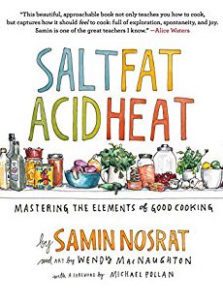 But are we doing the right things to achieve our goals?
But are we doing the right things to achieve our goals?
A cookbook, yes, a cookbook, can help us with perspective. It’s called Salt, Fat, Acid, Heat: Mastering the Elements of Good Cooking, by Samin Nosrat.
Like gazillions of cookbooks, there are gazillions of horsemanship books and DVDs offering recipes for solving certain issues and advancing certain movements. But do they really make us better?
Cooking and horsemanship require the ability to make adjustments all the time and in the heat of the moment. How do you teach that?
In the foreword to Salt, Fat, Acid, Heat, Michael Pollan writes:
“A recipe might teach you how to produce the dish in question, but it won’t teach you how to cook, not really. Truth be told, recipes are infantizing: Just do exactly what I say, they say, but don’t ask questions or worry your little head about why. They insist on fidelity and faith, but do nothing to earn or explain it.”
This cookbook is less concerned with recipes and more concerned with principles. Master them and you hardly need recipes. As Pollan notes:
“Think how much more we learn – and retain! – when a teacher doesn’t just enumerate the step-by-step instructions but explains the principles behind them. Armed with reasons, we no longer have to cling to a recipe like a lifeboat; now we can strike out on our own and begin to improvise.”
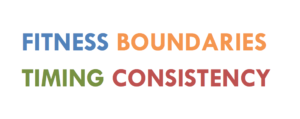 Brilliant! Let’s apply this notion to horsemanship. As a long-time learner and experimenter, four key principles came to mind right away. For me, horse work bubbles down to the importance of: Fitness, Boundaries, Timing, and Consistency.
Brilliant! Let’s apply this notion to horsemanship. As a long-time learner and experimenter, four key principles came to mind right away. For me, horse work bubbles down to the importance of: Fitness, Boundaries, Timing, and Consistency.
West Taylor reminded me to think of Boundaries, not the less appropriate concept, 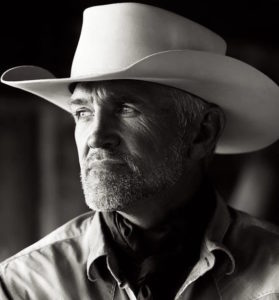 “Respect.” He said:
“Respect.” He said:
“I don’t feel that the horse operates in the range of respect as we humans use the word. I show the horse what my boundaries are and then reinforce the boundaries. I expect the horse to maintain the boundaries, not out of respect for me. That’s just how it is with me, all the time.
We visited with several folks on the notion of Mastering the Elements. Here are their thoughts:
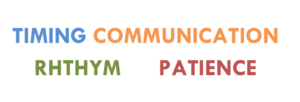 Dr. Steve Peters, a presenter at this fall’s Best Horse Practices Summit, contributed his four elements. They are: Timing, Communication, Patience, Rhythm. Peters writes:
Dr. Steve Peters, a presenter at this fall’s Best Horse Practices Summit, contributed his four elements. They are: Timing, Communication, Patience, Rhythm. Peters writes:
Timing is important from a neurochemical standpoint. Learning happens when dopamine reinforces synaptic changes in neurons that are activated just before the reward was presented.
This phenomenon is tied to Communication because I need to be clear and I need the horse to show me that it is in the right neurochemical state of arousal for learning to occur. Read more about Learning here.
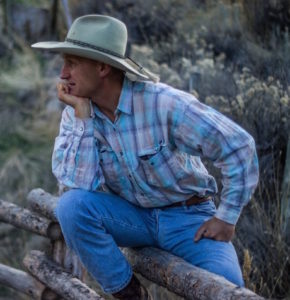
Dr. Steve Peters
Horses can master understanding when we help them find what behaviors we are reinforcing. They learn to respond to subtler messages and finer cues with a greater understanding of what is being asked of them without undue pressure.
If the human’s communication is good, they can grasp ever more complicated behavioral requests more quickly.
Rhythm is related to balance. We need to learn to be aware of the horse’s movement and to move with them. Rhythm applies not just when we are riding but also when we move around them and even how we touch them.
Patience:
When cooking, you probably don’t want to broil your pastry even if you don’t think it is baking quickly enough. With horse work, it’s important to avoid activating the amygdala (which is tied to fear and aggression). To cook properly and to work with horses properly, it takes as long as it takes.
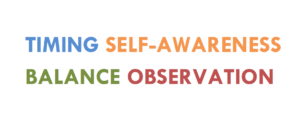 Horsewoman Amy Skinner related what principles she held dear, what elements every rider should strive to master: Balance, Timing, Observation, Self-Awareness. She writes:
Horsewoman Amy Skinner related what principles she held dear, what elements every rider should strive to master: Balance, Timing, Observation, Self-Awareness. She writes:
Balance is essential in many ways:
- You want the horse to be balanced from front to back, right to left, physically and mentally.
- He needs to be given a balanced life and presented with stimuli in a balanced way so that he isn’t overloaded with more
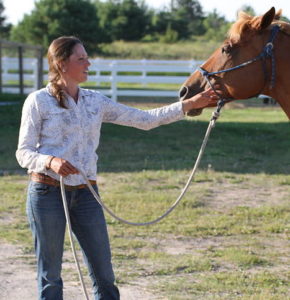
Amy Skinner
than he can handle, but not so little that he has no incentive to try.
- He needs balance between being spoiled and being forced. There is disciplined area right in the middle.
- The rider also has a huge responsibility to be balanced on the horse. Anything we ask of the horse can be made obvious and easy if we’re in the right position, but if our weight is unevenly distributed or if we cause imbalance in their bodies, we have to use more force or pressure to accomplish what could be much easier.
Timing is essential for making the right thing obvious.
- If we get in time with the horse’s feet, the movements we ask for are simple for the horse to understand and carry out.
- If we ask for things at the right time, and if we know when to let off pressure or let the horse have a rest, we can make leaps and bounds in progress because we are working in a way they can understand.
Observation:
- The older I get, the more I realize that working with horses should be less about doing and more about watching and listening. Too much doing brings up the horse’s self-defense.
Self-awareness may be the most important part of working with horses. I’ve learned a lot about myself over the years and the better I’ve gotten to know my own tendencies, the more I can offer horses. Learning to be patient, to keep our egos out of riding, to keep tempers down, to keep expectations healthy is all part of a self-awareness that’s essential to good riding.
Randy Rieman wrote in the foreword of Evidence-Based Horsemanship: “Timing, Feel, and Balance are the holy trinity of 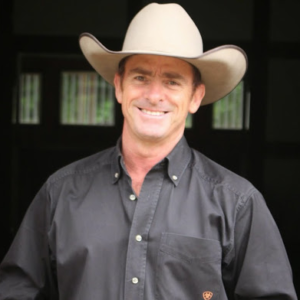 horsemanship. These are also the key ingredients for success in many other areas of life.”
horsemanship. These are also the key ingredients for success in many other areas of life.”
Warwick Schiller, a Best Horse Practices Summit presenter, has this to say about understanding Timing. Check out the helpful video here.
Schiller adds: Mindfulness is essential. Horses are great readers of energy and even greater readers of all of the baggage we drag along to the round pen. You can’t have feel without it.
- If you are thinking about your shopping while riding you won’t have feel.
- If you are thinking about work you won’t have timing .
- If you are not mindful you will not have empathy (which is very important, too)
- And if you are thinking about the end result instead of being present, you won’t have patience.
The other element I stress is Knowledge of how horses learn. If you don’t understand how horses learn, you won’t be making much progress.
Many thanks to Schiller, Skinner, Taylor, and Peters for their contributions to this article.
What elements do you think are essential? Let us know by commenting below.
Are you just getting started on your horsemanship journey? Read about Ownership here.